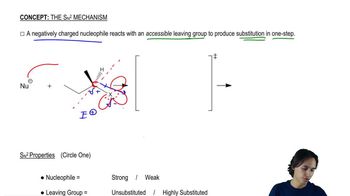For each pair, predict the stronger nucleophile in the SN2 reaction (using an alcohol as the solvent). Explain your prediction.
g. (CH3)2CHO– or CH3CH2CH2O–
h. I– or Cl–
 Verified step by step guidance
Verified step by step guidance Verified video answer for a similar problem:
Verified video answer for a similar problem:



 6:21m
6:21mMaster Understanding the difference between basicity and nucleophilicity. with a bite sized video explanation from Johnny
Start learning